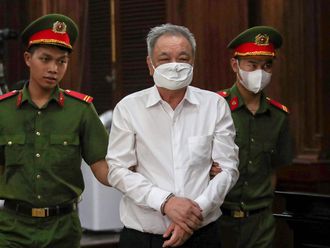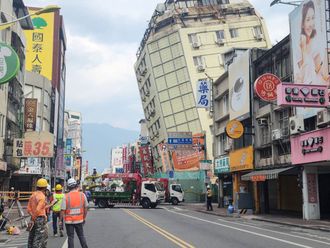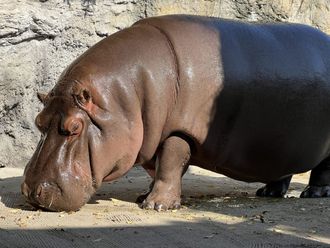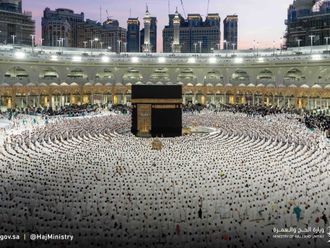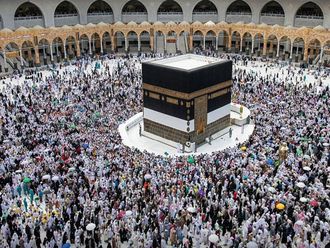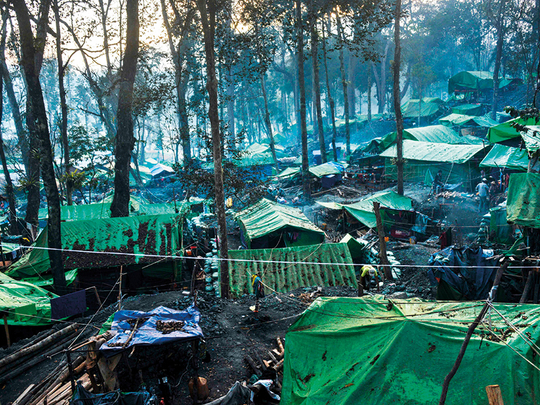
Myitkyina, Myanmar: ‘Amber hunters’ on a quest for a Jurassic Park-style discovery of dinosaur remains sift through mounds of the precious resin in Myanmar — a lucrative trade that captivates palaeontologists but also fuels a decades-long conflict in the far north.
The morning amber market on the outskirts of Myitkyina, the capital of Kachin state, throngs with traders using torches and magnifying glasses to scrutinise pieces of the honey-coloured fossilised tree sap.
Some sell rough-edged uncut chunks. Others tout finished products: pendants, necklaces and bracelets made from carefully polished pieces.
The trading takes place just a few dozen kilometres from the fighting between Myanmar’s army and ethnic Kachin rebels battling for autonomy, land, identity — and natural resources that help finance both sides.
The jade and ruby industries dwarf the largely artisanal amber trade, but the resin can still fetch big sums for whoever controls the mines.
In Myitkyina’s market there is money to be made, says trader Myo Swe.
His speciality is “inclusions”, sap that has trapped parts of plants, animals and even dinosaurs before hardening into amber — history suspended inside the resin.
Find the right buyer and he could pocket up to $100,000 (Dh367,300) a piece in a shady industry that sees most amber smuggled across the border to China.
“Even if it just contains an ant or a mosquito — every piece is interesting,” the 40-year-old told AFP. “I value every one of them.”
Dinosaur tales
years ago is how far back most amber dates
Amber, historically coveted as jewellery by nobility from China to ancient Greece, enjoyed a revival in popular culture thanks to the 1990s hit movie ‘Jurassic Park’, set in a theme park where dinosaurs have been cloned by extracting DNA from mosquitos preserved in the resin.
However, most amber heralds not from the Jurassic but from the later Cretaceous Period, up to 100 million years ago.
The best preserved “inclusions” offer today’s scientists and collectors a three-dimensional fossil, with some creatures even frozen mid-movement.
amount some pieces of amber fetch on market
There are amber deposits found all over the world but, for palaeontology, the mines of Kachin are “irreplaceable”, explains 36-year-old Lida Xing from the China University of Geosciences in Beijing.
“The amber mining area in Kachin is the only Cretaceous period amber mining site in the world that is still engaged in commercial mining,” he says. “There’s no better place than Myanmar.”
Lida Xing shot to fame among fellow palaeontologists in 2015 when he brought back part of a feathered dinosaur tail to China from Myanmar that dated back some 99 million years.
The excitement of his discovery, though, was tinged with disappointment when he returned to try to find the source.
“They said they did not know. They had probably already sold or smashed it. This dinosaur might have even been a complete one with a head,” he told AFP in Beijing.
‘Conflict amber’
Amateur amber hunters aside, the main challenge for traders and collectors is working in a conflict zone.
people displaced by conflict in region
An upsurge in fighting between the army and the Kachin Independence Army (KIA) over recent years has left more than 100,000 people displaced in the region.
Leaflets dropped by army helicopters in June last year even warned people living around the mines to leave the area or be considered to be cooperating with the rebels, according to Human Rights Watch.
Now only the hardiest of amber hunters attempt to go there.
“We almost could not reach the mining area because it was very dangerous,” Lida Xing says of his 2015 trip. “We sneaked in when the situation eased quite a lot, but no scientist was able to go inside after that.”
“This is a severe problem because, for palaeontology, you obtain a lot of useful information from the geological conditions and strata - but we were not able to do this.”
Amber, jade, timber and gold are also “major drivers” of the conflict in northern Myanmar, says Hanna Hindstrom from monitoring group Global Witness.
Without sourcing responsibly, any company trading Myanmar amber “could be causing or contributing to a range of harms including conflict and human rights abuses”, she adds.
Akbar Khan, a 52-year-old self-described “extreme fossil in amber hunter” who runs a streetside stall in downtown Bangkok shrugs off the risks and ethical questions.
He makes frequent visits to Kachin and explains the adrenaline rush he gets from finding dinosaur parts is like nothing else.
“You feel like you’re walking in clouds, in heaven,” he says.
“If people have a big diamond, so what? The world is full of big diamonds... but the world is not full of dinosaurs in amber.”


